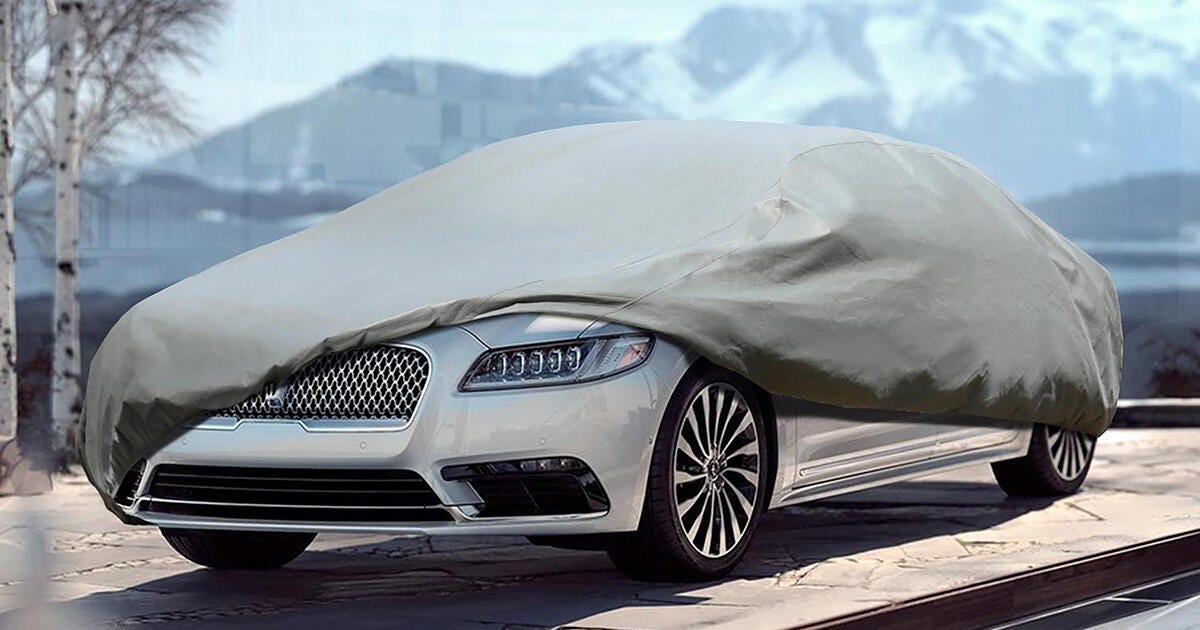Best Car Covers for 2022
Whether you collect cars or simply want to keep your everyday ride in pristine condition, you probably already know how hard proper maintenance can be. No matter how careful you are, exposure eventually takes a toll on the paint and exterior. If you really want to minimize wear, then you should start using a car cover.
A car cover is a piece of material fitted to slip on and off of your car relatively easily, protecting it from weather, bird droppings, harmful UV rays and wear when you aren’t driving it. While that may sound simple in theory, there are many different kinds of car covers, which can make shopping a challenge. You can get a custom fit car cover with adjustable straps or reflective strips.
Here are our recommendations for the best car covers across a variety of categories, based on customer satisfaction ratings and expert opinions. Keep reading afterwards for more information about the different types of car covers, how they differ and the best ways to use them.
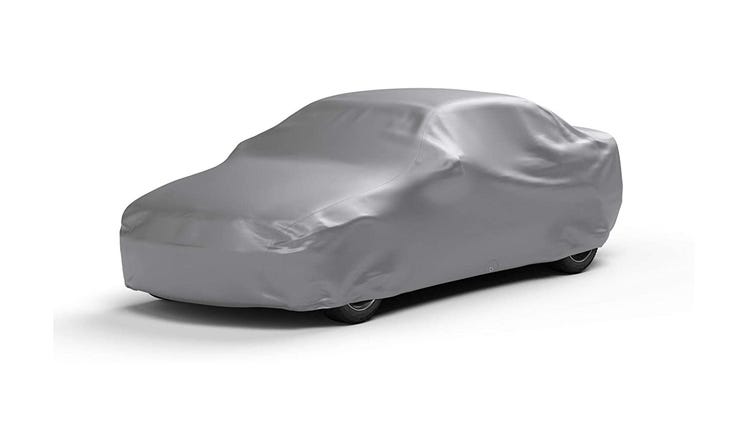
CarCovers.com
The best overall car cover should be effective both indoors and outdoors — and the Platinum Shield Car Cover is just that. This custom fit cover is weatherproof and highly rated against outdoor elements such as rain, snow and other forms of precipitation, but it also protects against the dust, rot and mildew that can accumulate when your car is parked in a garage.
The polyester material that comprises the cover is a breathable fabric, which means moisture won’t get trapped underneath and ruin your car’s paintwork. The inside lining is soft fleece, which means the cover itself won’t cause any scratches or damages. It also features reinforced seams. The whole thing comes with a limited lifetime guarantee, meaning it’s a good investment even though it’s on the expensive side.
Please note that the Platinum Shield cover is a custom fit car cover designed specifically for individual makes, models and years of vehicles. In order to find the one that’s right for you, you’ll need to search specifically for your car in order to get a custom cover that offers a snug fit.
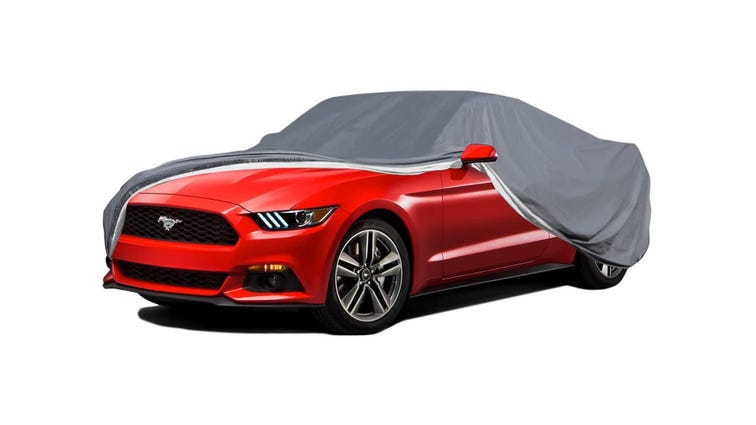
OxGord
The OxGord Executive Storm-Proof Cover packs a mighty punch when it comes to protecting your vehicle from the demands of the great outdoors — especially weather conditions like rain and water. The cover is made of an astonishing seven layers of material — five polypropylene, one micro-porous film and one cotton. However, all those layers don’t mean that the vehicle cover sacrifices breathability, so you don’t have to worry about moisture getting trapped underneath it.
While the Executive Storm-Proof Cover isn’t custom fit to your vehicle’s specific make and model, this breathable cover is available in a variety of sizes, which means you can get a tight fit that won’t blow around too much in high wind like some universal car cover options. This quality car cover also comes with a storage bag and a patch with a hole for your antenna, if you have one.
As the Executive Storm-Proof Cover is only $70, it’s an outdoor cover that offers a good deal of elemental protection at a reasonable price.
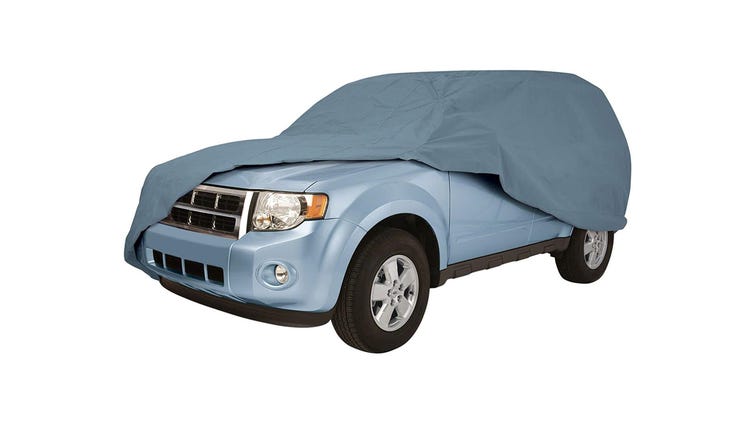
Classic Accessories
Just because your car is largely protected from inclement weather when it’s parked indoors doesn’t mean that it’s not exposed to other risks — including moisture, dirt and possibly animal scratches. The right indoor car cover may not need to be weatherproof, but it should be breathable, protective and soft on the inside.
The Classic Accessories OverDrive PolyPro checks those three boxes, making it a great indoor cover choice for when you’re keeping your car in a garage. This quality care cover is also water repellent, so if you need to use it outdoors in a pinch, it can protect your car from light to moderate rain. As one of the cheaper covers on this list, it provides a great value for users.
Please note that the Classic Accessories OverDrive PolyPro Car Cover is a universal fit cover with elastic hem corners. They are, however, offered in a variety of sizes for both cars and SUVs. Classic Accessories OverDrive PolyPro 1 Compact Sedan Car Cover (Fits Cars up to 13′ L) is currently unavailable at Amazon.
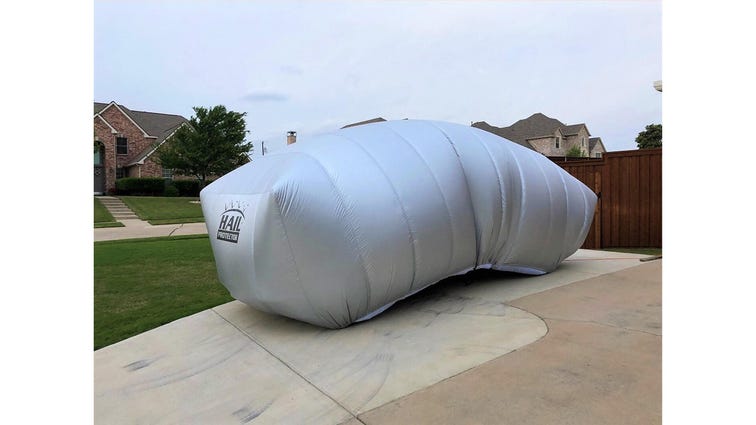
Hail Protector
More than any other form of precipitation, hail poses a hazard to your car. Since the size of the ice chunks that rain down from the sky can range from small pebbles to full-sized rocks, your best bet for avoiding the dangers of hail is to park inside. Failing that, your best bet is the Hail Protector.
You don’t need to look at the Hail Protector for long to realize that it’s a different kind of car cover. It’s inflatable, which means that it takes up more space. You won’t be able to use it in a parking lot, or if you’re parked on the street. If you’re keeping your car in your driveway, though, the Hail Protector can provide a level of hail protection that few other car covers can match.
At $489 (for the smallest size), the Hail Protector is costly. It also takes a while to set up, since it needs to be inflated. That said, your car or SUV coming out of a single hailstorm unscathed could make it all worthwhile.
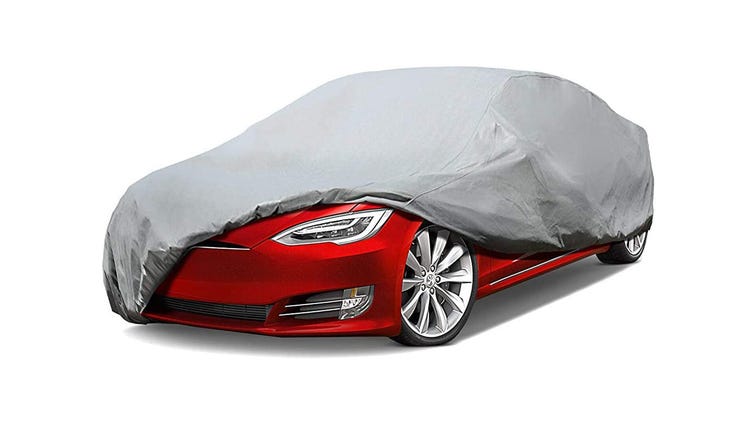
Leader Accessories
Winter provides unique challenges for automobile exteriors — snow falls on cars, sometimes piling up and not melting for days, weeks or until you clear it off. For such a demanding season, a car owner needs the right car cover.
The Leader Accessories Platinum Guard car cover is made from seven different layers of material (four polypropylene, two ultraviolet coating and one cotton), providing coverage against snow or freezing rain. The cover is breathable, so if any moisture accumulates inside, it will evaporate before damaging the car paint. It also has heavy-duty buckles designed to keep it fastened in high winds.
The Leader Accessories Platinum Guard currently has 4.3 out of 5 stars on Amazon, with over 400 customer ratings.
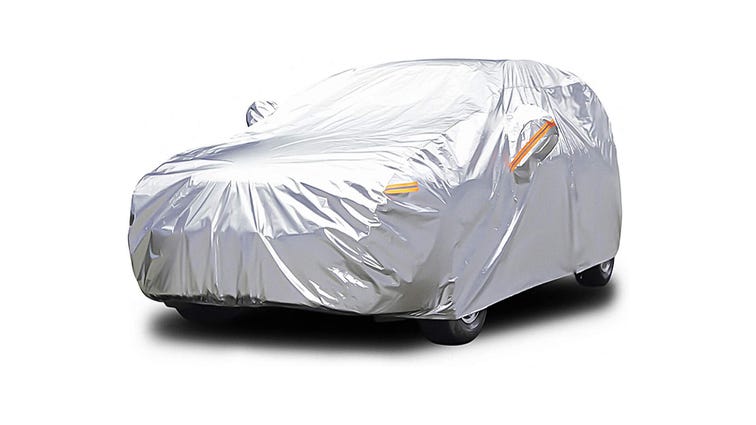
Audew
Outdoor car covers don’t just protect your vehicle from the harmful effects of precipitation — there’s also the sun, which emits ultraviolet rays that can damage your paint over time. On hot days, the sun will also raise the temperature in your car by a significant amount.
The Audew 6 Layers Car Cover is ideal for blocking those UV rays — and repelling some of the heat that would otherwise get into your vehicle. It’s got six layers of different quality car cover material that make it thicker and softer than many other covers, as well as mirror pockets to protect the sideviews. It’s also waterproof, windproof and dustproof, so it’s effective protection against all sorts of weather.
Audew’s waterproof car cover with UV protection is affordable as well — the sedan model is $50, while the truck model is $90.
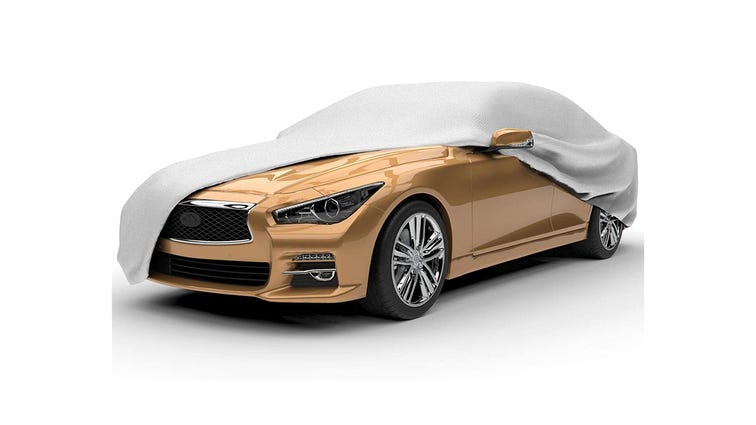
Budge Lite
Budge’s Lite Car Cover is described by the company as an “entry-level model.” It doesn’t have multiple layers of material and it’s only recommended for “occasional outdoor usage,” but it provides good indoor protection at a low price — only $32 for a standard sedan size. For small SUVs, it’s $50.
The polypropylene cover is breathable, which means that moisture that accumulates underneath can evaporate without causing build-ups of mold and mildew. This lightweight car also has an elasticized hem at the bottom that allows it to grip a vehicle fairly securely, even if you choose not to use a cable with the included grommets.
And just because the Budge Lite Car Cover is ultra-affordable doesn’t mean that it sacrifices performance. It currently has an average of 4.1 out of 5 stars on Amazon, based on nearly 5,000 customer ratings.
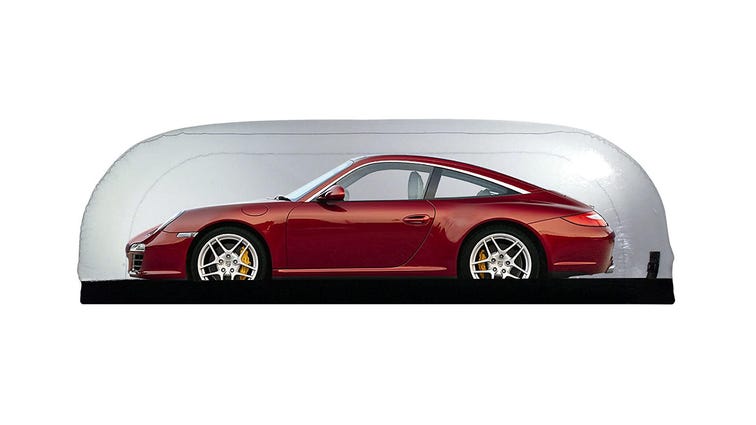
CarCapsule
With the exception of your house (if you own one), your car is probably your most valuable asset — so maybe it makes sense to spend a little more to protect it. After all, any damage to your vehicle will be costly to fix. And as the saying goes, an ounce of prevention is worth a pound of cure.
The CarCapsule is your ounce of protection. Like the Hail Protector, it’s inflatable, providing a shield that covers your whole vehicle with room to spare. However, the CarCapsule is designed for indoor use, with a built-in fan that filters out moisture, preventing condensation. This will keep your car pristine for as long as possible.
Though the model linked here is 16 feet long, the CarCapsule comes in a variety of sizes and price points. Most vehicles can be accommodated by one of them. CarCapsule makes covers for outdoor use, as well. Note: CarCapsule CC20TF Large X-Tall 20 inch car cover is currently unavailable at Amazon.
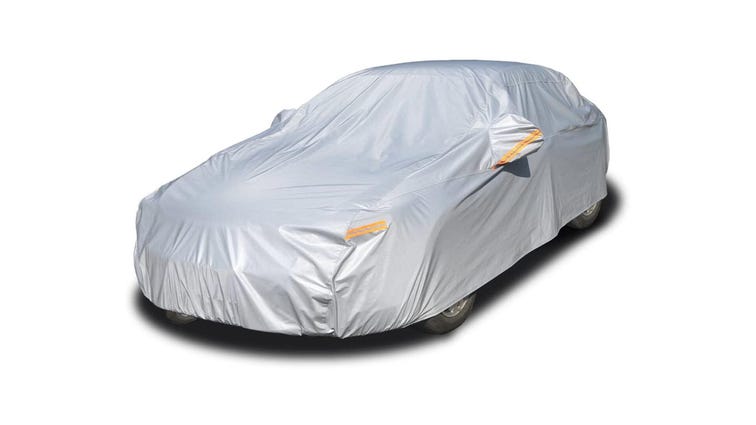
Kayme
If you’ve ever fully attached your car cover and then remembered you left something important inside, you know how annoying that can be. Even if the cover only takes a minute or so to take on and off, it’s extra time that keeps you from getting where you’re trying to be.
Thankfully, there are covers like the Kayme Six Layers Car Cover, which features a panel with a zipper that allows vehicle access without taking the cover off entirely. Simply unzip and you can get back in your car in a matter of seconds.
It also doesn’t hurt that the Kayme Six Layers Car Cover is affordable ($65 for a sedan), waterproof and has reflective aluminum that helps keep the sun’s rays at bay. It’s little surprise that Kayme’s cover is the best-selling car cover on Amazon.
Comparison of the best car covers in 2021
| Brand | Model | Price | |
| Best car cover overall | CarCovers.com | Platinum Shield | $195 |
| Best car cover for outdoor storage, rain and water | OxGord | Executive Storm-Proof | $70 |
| Best car cover for indoor storage | Classic Accessories | OverDrive PolyPro | $36 |
| Best car cover for hail | Hail Protector | Hail Protector | $489 |
| Best car cover for winter | Leader Accessories | Platinum Guard | $70 |
| Best car cover for sun | Audew | 6 Layers Car Cover | $42 |
| Best affordable car cover | Budge | Lite Car Cover | $32 |
| Best car cover if money is no object | CarCapsule | CarCapsule | $499 |
| Best car cover with a door zipper entry | Kayme | Six Layers Car Cover | $65 |
There’s a car cover available for almost every storage situation.
Budge
What to know about car covers
A car cover has more car owner benefits than you may realize. Yes, the right car cover keeps outdoor elements like rain, snow and dust from collecting on your vehicle. It protects against scratches and other minor forms of damage, but it also helps moderate the temperature inside the vehicle. After all, a cover will block out the sun on a hot day and provide an extra layer of insulation on a cold one. If you have a breathable car cover, you can prevent rust accumulation, as well — even if you live by the sea. Car covers are typically designed for either outdoor use or indoor use.
The wrong car cover can potentially cause damage to your vehicle’s paint job. Outdoor covers are built to be more durable than indoor covers, but if they don’t have a soft interior lining, they could cause scratches. Likewise, a car cover that doesn’t fit well could rub against your vehicle, especially when exposed to wind. Finally, if the fabric is weatherproof, but not breathable, then moisture might get caught under the cover (again, this is more likely when parked outdoors). That moisture could also damage the paint. For that same reason, you shouldn’t put a car cover on a wet car.
“When possible, apply your car cover to a dry car surface,” says Kaitlyn Short, senior content editor for BestCompany.com‘s automotive vertical. BestCompany.com curates user reviews and creates rankings of companies across a variety of categories. “A best practice is to wipe off any residual water with a microfiber towel before applying the cover. You should also try to keep the cover and your car clean. Car covers can easily become dirty, increasing the chance for scratches the next time you want to use them. Try to reduce dust and debris on your car before applying the car cover.”
If you have a few bucks and prefer not having anything touch your car, the CarCapsule is an excellent car cover choice.
CarCapsule
Outdoor car covers are subjected to different external factors depending on the time of year, so it makes sense to find one that’s versatile. Winter is a particularly important time to cover a car due to the risk of snow, but during the winter, you may find that your cover has frozen and stuck to your car. Rather than trying to pull the cover off, you should pour hot water on the cover until the frost melts and it can be removed easily.
None of this is to say that indoor car covers are any less necessary than outdoor ones. They offer protection against different hazards, many of which depend on whether you’re parked in a public or home garage. These risks range from pollen to moisture to animals, all of which can easily cause superficial damage to an uncovered car.
Choosing the right car cover
Car covers are available in a variety of materials, and the one that’s best for you will depend on your needs, such as the environment in which your car will be parked. Soft cotton covers, for instance, are good for protecting cars that will be parked indoors, but they’re not waterproof, so they’re not recommended for people who plan on keeping their vehicles outside. Outdoor car covers need to withstand more environmental hazards, so many companies use proprietary fabrics designed to weather sunlight and precipitation.
Outdoor car covers are made from materials designed to handle the elements.
Leader Accessories
“For car covers used indoors only, the best car cover material is cotton-based, ranging from light laminated cotton to thicker woven and napped flannel,” says Karen Condor. Condor is a writer, editor and expert at 4autoinsurancequote.com, a company that matches drivers with insurance companies and creates content around protecting drivers and cars. “For car covers used outdoors, the best material is synthetic fabric of multiple layers, such as solution-dyed polyester and acrylic microfibers, which can be just as soft as cotton but also provide natural ultraviolet light and mildew resistance and water repellency.”
Sizing is another concern when selecting a car cover, as a cover that’s too large can potentially cause the type of damage you’re trying to avoid. Many manufacturers have their own sizing charts based on either measurements or car makes and models for a more custom fit cover. You’ll want to make sure you have all the necessary information before buying a cover. For this reason (and because of breathability concerns), it’s not recommended to use a tarp as a car cover, or anything besides a cover specifically designed for your vehicle.
Remember, your personal circumstances will dictate which car cover is right for you. Consider factors such as where you’ll be parking, your area’s climate and your car’s size before you make your selection.
Proper car cover fitment is important to prevent potential damage to your car’s paint.
Audew
How to use and take care of a car cover
Once you’ve bought your car cover, putting it on your car is relatively easy. Usually, one side is marked “front,” and you can affix that side to the front bumper. After that it’s a matter of pulling it evenly so it doesn’t bunch and then securing it to the back bumper. The whole process doesn’t take long and can be done anywhere you park.
A car cover’s job is to protect your car, but it needs attention of its own in order to last for as long as possible. Most car covers are machine washable, but each still comes with its own instructions for proper cleaning, which ought to be followed exactly in order to maintain efficacy and longevity. You shouldn’t use fabric softener and while hand washing is typically acceptable, dry cleaning is not. Make sure to use cold water when washing a car cover.
Don’t forget to keep your car cover clean with an occasional wash.
OxGord
Additionally, you can wash your cover as needed — if you follow instructions, regular washing shouldn’t damage the cover. Car covers, of course, are liable to get dirty fairly quickly — there’s never a bad time to put a cover on a parked car, so just think about all the dirt (and worse) that can accumulate with that level of use.
“Since protecting your vehicle’s paint and reducing wear on the interior can help the trade-in value,” says Condor, “you should cover your car when you want to protect it from dust, dirt, pollen, bird excrement, tree sap and branches, sun and UV rays, heat, rain, snow, sleet and hail.”
When not using your car cover, the safest place to keep it is in a storage bag. That way, you won’t have to worry about dust or any other environmental hazards.
Worried about hail? The Hail Protector will keep your ride protected.
Hail Protector
Five things to know before buying and using a car cover
- Do you want an indoor car cover or an outdoor car cover? This will hinge on where you primarily park your car, but if it varies, you may want to get one of each.
- If you’re getting an outdoor car cover, what’s the weather like where you live? Do you live by any large bodies of water? This information may seem obvious, but you’ll want to take full stock of it, because the outdoor elements will likely affect the material of the cover you buy.
- If you’re getting an indoor car cover, what will be going on in the garage where you park your car? If your car will be exposed to physical hazards, you may want to get a thicker or padded cover.
- What size is your car? The size of your car will obviously affect the size of your cover. Since you want a tight fit, it pays to be as precise as possible.
- How can you best care for your car cover? Make sure to familiarize yourself with storage and washing instructions prior to use in order to ensure that your cover lasts as long as possible.
Written by Scott Fried for Roadshow.
More for auto enthusiasts
For all the latest world News Click Here

